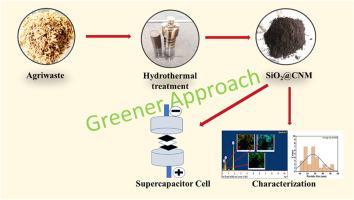用于超级电容器应用的农业废弃物(稻壳)SiO2混合碳纳米材料的绿色合成和机器学习驱动分析
IF 4.7
3区 材料科学
Q2 MATERIALS SCIENCE, MULTIDISCIPLINARY
引用次数: 0
摘要
在寻求可持续解决方案的过程中,从农业废弃物(AW)中开发了一种高性能超级电容器电极材料。该研究使用一锅绿色方法在240°C下从AW中制备了SiO2混合碳纳米材料(SiO2@CNM)。这种纳米材料具有高表面积和多孔片状结构,使用三种不同的电解质:1 M H2SO4, 1 M KOH和1 M Na2SO4来评估其超级电容行为。合成的材料在三电极系统中,在电流密度为0.5 Ag-1、H2SO4浓度为1 M时,比电容达到679.9 Fg-1。当在双电极系统中配置成对称超级电容器时,1MH2SO4中的SiO2@CNM在1 Ag-1时提供了371.8 Fg-1的比电容。该电极-电解质结构在0.5 Ag-1下的能量密度为51.64 Whkg -1,功率密度为249.97 Wkg-1。值得注意的是,该材料在5000次充放电循环后保持了超过80%的电容,使SiO2@CNM成为储能应用的有希望的候选者。1 M H2SO4的性能超过了其他电解质,突出了SiO2@CNM作为超级电容器应用的有效材料的潜力。此外,为了补充这些实验结果,使用不同的机器学习(ML)回归模型,即随机森林,梯度增强,XGBoost和AdaBoost来确定扫描速率和电流密度等参数在估计比电容中的重要性。特征重要性分析确定扫描率是影响比电容最显著的因素,为预测和优化操作条件和合成参数提供了框架。本文章由计算机程序翻译,如有差异,请以英文原文为准。

Green synthesis and machine learning driven analysis of SiO2 mixed carbon nanomaterial from agriwaste (Rice Husk) for supercapacitor applications
In the quest for sustainable solutions, a high-performance electrode material for supercapacitors was developed from agricultural waste (AW). The study used a one-pot greener approach to create a SiO2 mixed carbon nanomaterial (SiO2@CNM) from AW at 240 °C. This nanomaterial, with its high surface area and porous sheet-like structure, was evaluated for supercapacitive behavior using three different electrolytes: 1 M H2SO4, 1 M KOH, and 1 M Na2SO4. The synthesized material showed exceptional specific capacitance, achieving 679.9 Fg-1 at current density of 0.5 Ag-1 with 1 M H2SO4 in a three-electrode system. When configured into a symmetrical supercapacitor in a two-electrode system, SiO2@CNM in 1MH2SO4 delivered a specific capacitance of 371.8 Fg-1 at 1 Ag-1. This electrode-electrolyte configuration achieved an energy density of 51.64 Whkg−1 and a power density of 249.97 Wkg-1 at 0.5 Ag-1. Notably, the material retained over 80 % capacitance after 5000 charge-discharge cycles, making SiO2@CNM a promising candidate for energy storage applications. The performance with 1 M H2SO4 surpassed other electrolytes, highlighting SiO2@CNM's potential as an efficient material for supercapacitor applications. Furthermore, to complement these experimental findings, different machine learning (ML) regression models viz. Random Forest, Gradient Boosting, XGBoost and AdaBoost were employed to determine the importance of parameters such as scan rate and current density in estimating specific capacitance. Feature importance analysis identified scan rate as the most significant factor influencing specific capacitance, providing a framework for predicting and optimizing operational conditions and synthesis parameters.
求助全文
通过发布文献求助,成功后即可免费获取论文全文。
去求助
来源期刊

Materials Chemistry and Physics
工程技术-材料科学:综合
CiteScore
8.70
自引率
4.30%
发文量
1515
审稿时长
69 days
期刊介绍:
Materials Chemistry and Physics is devoted to short communications, full-length research papers and feature articles on interrelationships among structure, properties, processing and performance of materials. The Editors welcome manuscripts on thin films, surface and interface science, materials degradation and reliability, metallurgy, semiconductors and optoelectronic materials, fine ceramics, magnetics, superconductors, specialty polymers, nano-materials and composite materials.
 求助内容:
求助内容: 应助结果提醒方式:
应助结果提醒方式:


